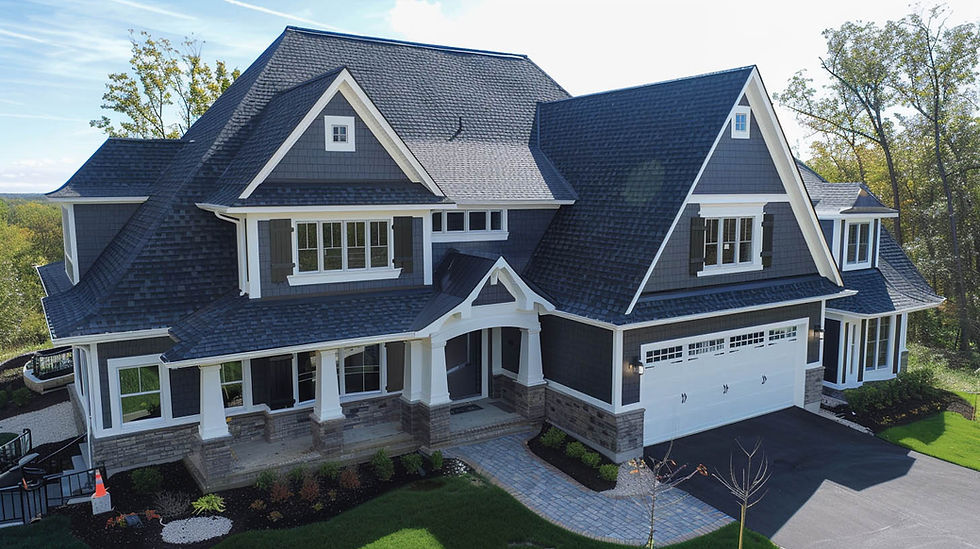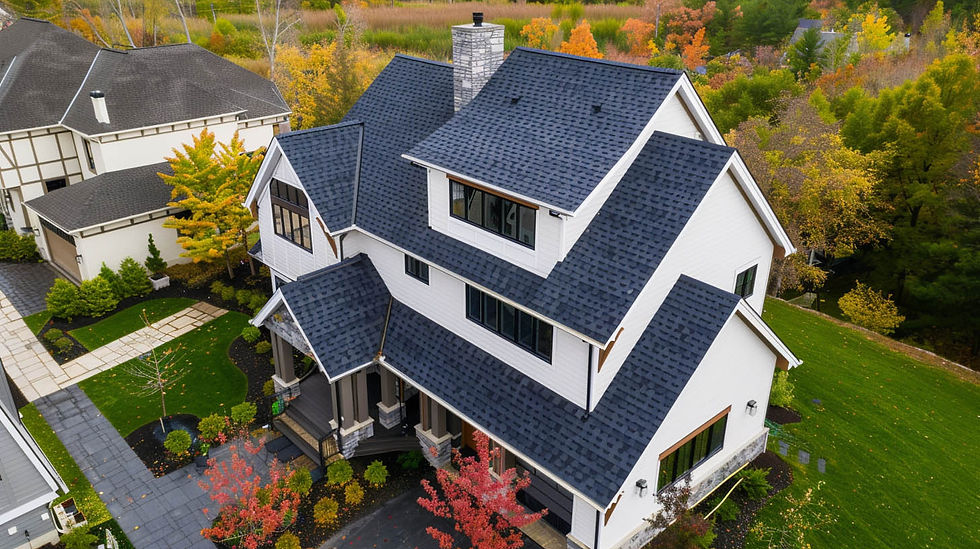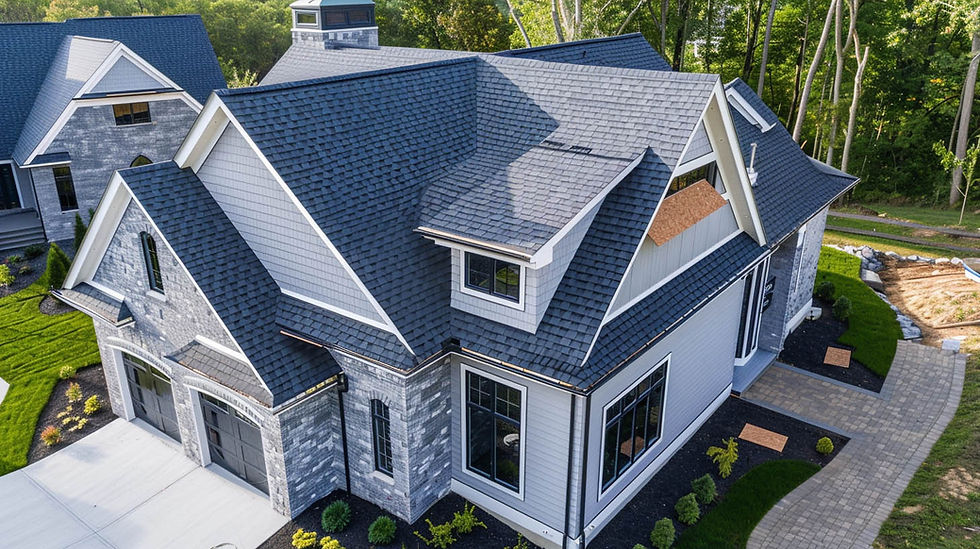How Roof Pitch Impacts Material Choice and Installation Complexity
- Vlad Antoniuk
- Sep 15, 2025
- 5 min read
Roof pitch is crucial for your roofing system. It impacts material selection, installation, and overall construction complexity. Knowing your roof pitch can extend its lifespan and durability in Allentown, PA. At East Penn Roofing, our experienced team understands the significance of roof pitch. Our certified professionals ensure excellent results for both residential and commercial projects. Here’s what you need to know about how pitch affects your roof.
Understanding Roof Pitch and Its Importance
The incline of a roof, or roof’s pitch, does more than just change the way a house looks. It is a key part of how well a roof works. The slope guides water drainage, helps pick the right materials, and protects against things like wind and snow.
Knowing what the roof’s pitch is can also show how hard it will be to put on the roof. It tells what tools and skill you need to get the job done right. At East Penn Roofing, we make sure to match the right materials with the right slope. This helps make your roof last longer, saves energy, and keeps your place safe.
What Is Roof Pitch?
The pitch of a roof indicates its steepness, expressed as a ratio of rise in inches for every 12 inches of horizontal run. For example, a “6:12 pitch” means a rise of six inches over 12 inches across. Roof slope is essential for effective water drainage and longevity.
Traditionally, local climate influenced pitch—steeper roofs in snowy areas allowed snow to slide off, while flatter designs were typical in drier regions.
Today, roof pitch combines personal style with practical needs like water resistance and structural support. By measuring the slope and considering local conditions, East Penn Roofing ensures your roof is both attractive and durable, ready to withstand years of rain, snow, and sun without losing integrity or appeal.

How Roof Pitch Is Measured
Determining the pitch of a roof involves calculating the vertical rise in relation to the horizontal run. This measurement is typically expressed as a ratio or in inches. For instance, a roof that rises 4 inches for every 12 inches of horizontal distance has a pitch ratio of 4:12. Accurate measurement of pitch is essential for effective material selection, ensuring appropriate water drainage, and complying with building codes. These factors work together to enhance the roof's performance and durability against various weather conditions.
Types of Roof Pitches and Their Characteristics
Understanding the various types of roof pitches is essential for optimal material selection and installation. Low-slope and flat roofs generally have a gentle incline, offering excellent water drainage but presenting challenges like water pooling. On the other hand, moderate to steep-pitch roofs, with their significant vertical rise, enhance drainage efficiency, making them suitable for regions with heavy snowfall or rainfall. Selecting the right pitch not only affects aesthetics but also impacts the roofing system's performance and longevity.
Low-Slope and Flat Roofs
Designing low-slope and flat roofs involves specific considerations around material selection and installation complexity. Typically characterized by a pitch less than 3:12, these roofs require suitable roofing materials that effectively manage water drainage to prevent pooling and potential leaks. Options like built-up roofing or membrane systems offer excellent weather resistance and energy efficiency. Proper installation techniques are crucial, as they address maintenance needs and ensure structural integrity, particularly in regions prone to heavy rainfall or snow loads, thereby minimizing long-term repair costs.

Moderate and Steep-Slope Roofs
Moderate and steep-slope roofs present unique challenges and opportunities regarding material selection. Steeper pitches enhance drainage efficiency and minimize water pooling, making materials like metal roofing, clay tiles, and cedar shakes ideal choices for their wind resistance and durability against heavy snowfall. However, the complexities of installation increase with the incline, necessitating a skilled team familiar with the intricacies of steep roof designs. Proper safety measures and adherence to building codes become paramount to ensure structural integrity and optimal performance over time.
How Roof Pitch Influences Material Selection
Material selection depends on your roof’s pitch. If you have a low-pitch roof, you need waterproof materials like EPDM and TPO. If your roof is moderate or steep, you can use other choices like asphalt shingles and metal panels.
Choosing the right materials helps your roof keep its strength and also makes it better for saving energy. At East Penn Roofing, we help you pick the best material for your roof pitch, so your roof lasts a long time. This way, you avoid the problems that come with using the wrong material choices.
Materials Best Suited for Low-Pitch Roofs
Low-pitch roofs, characterized by their gentle slope, require suitable roofing materials that ensure proper drainage and weather resistance. Membrane roofing systems such as EPDM and TPO are excellent choices due to their seamless installation, reducing the risk of leaks. Modified bitumen also offers good waterproofing and is conducive for maintenance. Incorporating materials like metal panels can enhance structural integrity while being lightweight, making them efficient for low-slope applications. Choosing the right material not only safeguards against water pooling but also aids energy efficiency.

Ideal Materials for Steep Roofs
Steep roofs need roofing materials that work well with their slope and give the best protection. Good choices include:
Asphalt Shingles: These are a cost-effective choice. They are flexible and have many design options.
Clay Tiles: These last a long time and do well with all kinds of weather.
Cedar Shakes: These keep heat inside and add a natural look.
The materials above help steep roofs deal with water drainage, heavy snow, and the need to look good. At East Penn Roofing, our GAF-certified team puts in each material the right way, so your roofing lasts long and looks great.
Contact Us Today
Understanding how roof pitch relates to materials and installation complexity is essential for a durable roof. Each roof pitch requires specific materials, each with its advantages and challenges. Choosing the right materials enhances roofing performance and simplifies installation. At East Penn Roofing, we take pride in our expertise and commitment to exceptional service. For a quote, contact us today—our team is ready to help you keep your home safe.
Frequently Asked Questions
Why is the pitch of a roof important?
The pitch of a roof is crucial as it affects drainage, ventilation, and the selection of materials. A steeper pitch may enhance water runoff, while lower pitches can accommodate specific materials but may require additional waterproofing measures. Understanding this relationship is essential for effective roofing solutions.
What is one factor that influence a choice of a roof?
One significant factor influencing roof choice is pitch, as it affects the selection of materials and installation complexity. For example, low-pitch roofs require specific materials to manage water drainage effectively, while steep roofs can accommodate different types of roofing options.
Read our blog: Does the Age of Your Roof Affect Your Insurance Coverage?




Comments